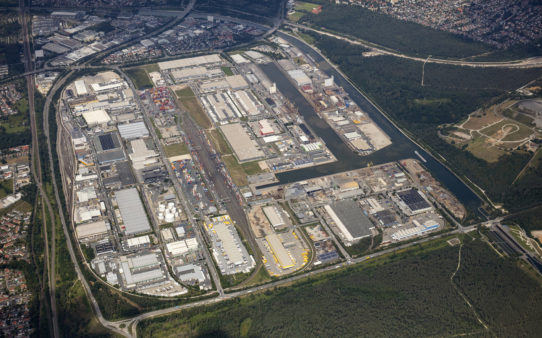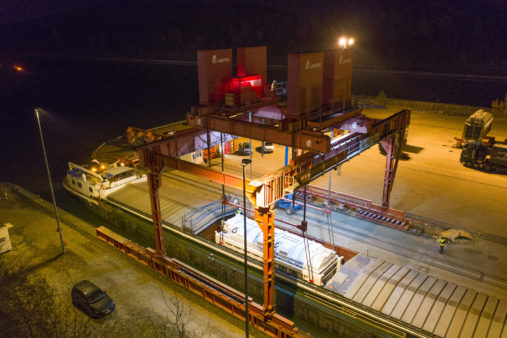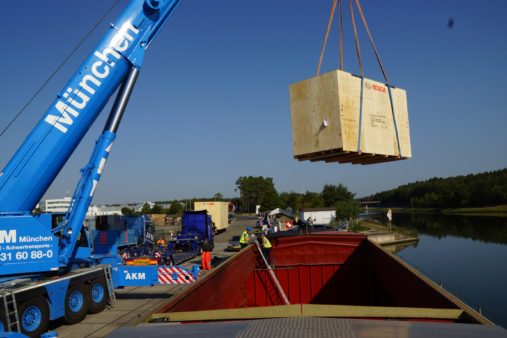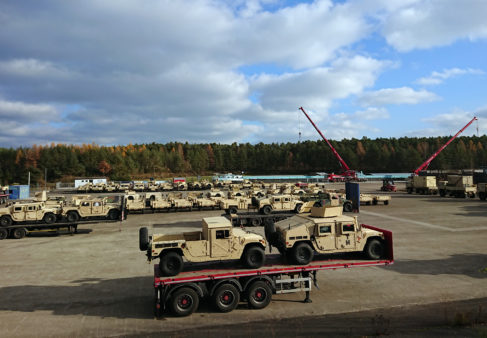11 March 2021 | Nuremberg
“bayernhafen Nürnberg is essential for our society”
2020 financial year: 3.7 million tonnes of goods moved by inland waterway and rail; bayernhafen invests around €1 million
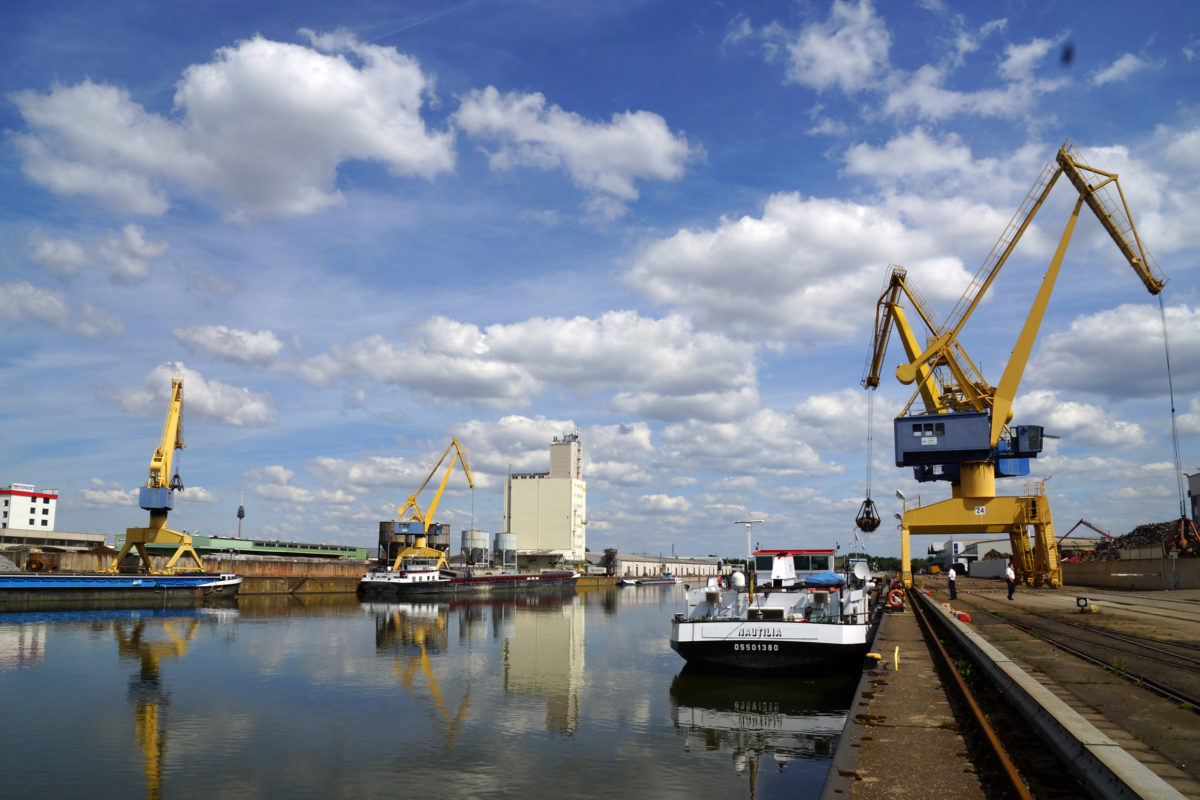
bayernhafen Nürnberg und bayernhafen Roth schlugen im Geschäftsjahr 2020 per Schiff und Bahn insgesamt 3,7 Mio. Tonnen (t) um – das sind trotz des Krisen-Jahres mehr als 85 % des Gesamtumschlags per Binnenschiff und Bahn von 2019.
Nürnberg and Roth, 11 March 2021 – bayernhafen Nürnberg and bayernhafen Roth together a highly diverse range of goods and shift long-distance traffic from the road networks to the two environmentally friendly transport modes of inland waterway and rail (at both locations) and rail (in Nuremberg). Even – and indeed, particularly so – in times of crisis, we must be able to rely on the steady supply of the goods that meet our daily needs and that companies in Bavaria can continue to deliver their products to their customers. In the 2020 financial year, bayernhafen Nürnberg and bayernhafen Roth moved a total of 3.7 million tonnes of cargo and freight by inland waterway and rail – over 85% of the total volume of goods transported by inland waterway and rail in 2019. This corresponds to around 590 fewer truck journeys per day.
Even – and indeed, in particular – in the year of crisis that was 2020, bayernhafen Nürnberg and bayernhafen Roth convincingly showed how essential to society it is that supply chains continue to work.”
Peter Stäblein
Chief Executive Officer, Hafen Nürnberg-Roth GmbH
In 2020, the cumulative cargo transferred by inland waterway in bayernhafen Nürnberg and bayernhafen Roth amounted to 276,961 tonnes – in the Corona year, more than 91% of the goods transported by inland waterway handled in 2019. Rail freight handling in bayernhafen Nürnberg fell by 14.6% to 3.4 million tonnes. The top commodity classes transported by inland waterway were fertilisers followed by minerals and earths; in rail freight handling, containers and mineral oil products.
“Even – and indeed, in particular – in the year of crisis that was 2020, bayernhafen Nürnberg and bayernhafen Roth convincingly proved how essential to society it is that supply chains continue to work,” says Peter Stäblein, who has been the Chief Executive Officer of the company that operates bayernhafen Nürnberg and bayernhafen Roth, Hafen Nürnberg-Roth GmbH, since February 2021. The experienced port manager, who steered the fortunes of the Berlin-based port and warehousing company BEHALA as Managing Director for 14 years and in 2019 had previously served as interim manager at bayernhafen, adds: “Inland ports play a key role in the supply of goods – and, through the supply chains they have established to maintain the flow of cargo and freight, the companies in bayernhafen Nürnberg and in bayernhafen Roth make a valuable contribution to ensuring that we get all of the goods we need to meet our daily needs.”
Along with Aschaffenburg, Regensburg and Passau, and Bamberg, Nuremberg and Roth are part of the bayernhafen group of companies. Even in times of crisis, through its skill in developing interfaces, bayernhafen continues to achieve its goal of making progress towards achieving the modal shift, because the ability of the bayernhafen locations to efficiently link the different transport modes enables businesses to use rail and inland waterway for long-distance transport as alternatives to transport by road. Through this strategy, bayernhafen is making a key contribution to tapping the full potential of the different transport modes. This takes pressure off the road networks and reduces CO2 emissions.
Totalling 274,746 TEU (twenty-foot equivalent unit), despite the year of crisis, container throughput in bayernhafen Nürnberg reached over 91% of the volume handled in 2019. “This is further proof that Combined Transport is one of the cornerstones of logistics,” says Peter Stäblein. This is evidenced through the fact that, since November 2019, the CT terminal in bayernhafen Nürnberg has also operated an intermodal train service to the seaport of Trieste in Northern Italy, and from there by ship to Greece, Turkey and the surrounding economic regions. The import and export goods that it transports primarily include automotive components, foodstuffs and consumer goods. The new intermodal train service between bayernhafen Nürnberg and Trieste is a welcome addition to the tried-and-trusted intermodal links to the German North Sea coast, to Rotterdam/NL, Verona/IT and to Chengdu in China.
Continued expansion of port infrastructure
In 2020, bayernhafen invested around €1 million at its Nuremberg and Roth locations in the re-development of its commercial sites and port infrastructure. This includes maintenance work on its rail infrastructure; in addition, plans to expand the CT terminal in bayernhafen Nürnberg are making good progress. As a ‘site architect,’ bayernhafen creates the conditions for providing high-intensity logistics companies with commercial sites in close proximity to rail and inland waterway facilities. Through strategic management of its land, bayernhafen’s consistent focus is on recycling, rather than consuming, land.
In 2021, bayernhafen is planning to renovate its quayside facilities and to optimise its crane fleet.
This will result in an efficient and environmentally friendly logistics chain in bayernhafen Nürnberg: intermodal trains for long distance and LNG-powered trucks for the initial and last mile legs.”
Peter Stäblein
Chief Executive Officer, Hafen Nürnberg-Roth GmbH
The new LNG service station in the metropolitan region of Nuremberg …
… is located in bayernhafen Nürnberg. It commenced operations in July 2020 and was officially inaugurated in October. It is operated by the Neumarkt-based energy supplier, Rödl energie, and BayWa Mobility Solutions GmbH in Munich. Peter Stäblein: “This will result in an efficient and environmentally friendly logistics chain in bayernhafen Nürnberg: intermodal trains for long distance and LNG-powered trucks for the initial and last mile legs. An extremely positive development for the location.”
Energy transition needs transformers – and transformers need bayernhafen Nürnberg
In 2020, the heavy-lift transfer site in bayernhafen Nürnberg dispatched project cargo 58 times to customers around the world. This included four 400-tonne transformers from the ‘Siemens Energy’ transformer plant in Nuremberg, destined for offshore wind turbines between Norderney and Emden operated by the electricity grid operator, TenneT. Just the job for the heavy-lift transport specialists, Züst & Bachmeier.
bayernhafen Roth: heavy-weights prefer barge
Heavy-lift also feels right at home in bayernhafen Roth: a 57-tonne boiler manufactured by Bosch was loaded on to barge in bayernhafen Roth, en route to Bremerhaven and to its final destination in Mexico. In addition, 286 military vehicles were shipped by barge via Antwerp to bayernhafen Roth, where they were loaded on to trucks to be transported to Grafenwöhr. “Further proof of the capabilities of the inland waterway system,” says Peter Stäblein.

